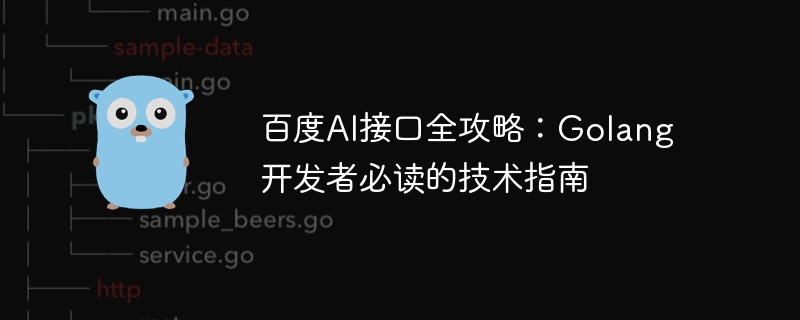百度AI接口全攻略:Golang开发者必读的技术指南

百度AI接口全攻略:Golang开发者必读的技术指南
引言:
随着人工智能技术的快速发展,越来越多的开发者开始关注和使用AI接口,以构建智能化的应用程序。在众多的AI接口提供商中,百度AI接口以其丰富的功能和简单易用的特点受到了广泛的欢迎。本文将以Golang为例,为开发者们提供百度AI接口的全攻略,包括接口的获取与使用方法,并附上详细的代码示例,帮助开发者们更好地理解和运用百度AI接口。
一、获取百度AI接口的认证信息
要使用百度AI接口,首先需要注册百度开发者账号,并创建一个应用。创建成功后,你将获得一个API Key和Secret Key,这两个认证信息将用于接口鉴权。
二、文字识别API示例
文字识别是百度AI接口中的一项重要功能,可以将图片中的文字提取出来。下面是一个使用Golang调用文字识别API的示例:
package main
import (
"fmt"
"io/ioutil"
"net/http"
"strings"
)
func main() {
apiKey := "Your API Key"
secretKey := "Your Secret Key"
token := getToken(apiKey, secretKey)
imageData := getImageData("test.jpg")
result := recognizeText(token, imageData)
fmt.Println(result)
}
// 获取access token
func getToken(apiKey string, secretKey string) string {
client := &http.Client{}
req, _ := http.NewRequest("POST", "https://aip.baidubce.com/oauth/2.0/token", strings.NewReader("grant_type=client_credentials&client_id="+apiKey+"&client_secret="+secretKey))
req.Header.Set("Content-Type", "application/x-www-form-urlencoded")
resp, _ := client.Do(req)
defer resp.Body.Close()
body, _ := ioutil.ReadAll(resp.Body)
return string(body)
}
// 读取图片数据
func getImageData(filename string) []byte {
imgFile, _ := os.Open(filename)
defer imgFile.Close()
imgData, _ := ioutil.ReadAll(imgFile)
return imgData
}
// 调用文字识别API
func recognizeText(token string, imageData []byte) string {
client := &http.Client{}
req, _ := http.NewRequest("POST", "https://aip.baidubce.com/rest/2.0/ocr/v1/accurate_basic", bytes.NewReader(imageData))
req.Header.Set("Content-Type", "application/x-www-form-urlencoded")
req.Header.Set("Authorization", "Bearer "+token)
resp, _ := client.Do(req)
defer resp.Body.Close()
body, _ := ioutil.ReadAll(resp.Body)
return string(body)
}在上述代码中,我们首先定义了getToken函数,用于获取access token,其中包括了我们在前面获取的API Key和Secret Key。然后,我们定义了getImageData函数,用于读取图片数据。最后,我们定义了recognizeText函数,用于调用文字识别API。在recognizeText函数中,我们将调用百度AI接口提供的文字识别API,并返回识别结果。getToken函数,用于获取access token,其中包括了我们在前面获取的API Key和Secret Key。然后,我们定义了getImageData函数,用于读取图片数据。最后,我们定义了recognizeText函数,用于调用文字识别API。在recognizeText函数中,我们将调用百度AI接口提供的文字识别API,并返回识别结果。
三、其他引人注意的百度AI接口
除了文字识别API外,百度AI接口还提供了许多其他的功能,如人脸识别、语音识别、图像识别等。在这里,我们只介绍其中的一部分。开发者们可以根据自己的需求选择合适的接口。
- 人脸识别API示例
人脸识别是一项非常有用的功能,可以检测图片中的人脸并识别其性别、年龄等信息。下面是一个使用Golang调用人脸识别API的示例:
// 调用人脸识别API
func recognizeFace(token string, imageData []byte) string {
client := &http.Client{}
req, _ := http.NewRequest("POST", "https://aip.baidubce.com/rest/2.0/face/v3/detect", bytes.NewReader(imageData))
req.Header.Set("Content-Type", "application/x-www-form-urlencoded")
req.Header.Set("Authorization", "Bearer "+token)
query := req.URL.Query()
query.Add("image_type", "BASE64")
query.Add("face_field", "age,gender")
req.URL.RawQuery = query.Encode()
resp, _ := client.Do(req)
defer resp.Body.Close()
body, _ := ioutil.ReadAll(resp.Body)
return string(body)
}在上述代码中,我们定义了recognizeFace函数,用于调用人脸识别API。在调用API之前,我们需要设置一些请求参数,如image_type表示图片类型为BASE64编码,face_field表示需要返回性别和年龄信息。
- 语音识别API示例
语音识别是一项非常强大的功能,可以将语音转换为文本。下面是一个使用Golang调用语音识别API的示例:
import (
"fmt"
"io/ioutil"
"net/http"
"strings"
)
// 调用语音识别API
func recognizeVoice(token string, voiceData []byte) string {
client := &http.Client{}
req, _ := http.NewRequest("POST", "https://aip.baidubce.com/rest/2.0/solution/v1/sound/echo", bytes.NewReader(voiceData))
req.Header.Set("Content-Type", "application/x-www-form-urlencoded")
req.Header.Set("Authorization", "Bearer "+token)
query := req.URL.Query()
query.Add("format", "pcm")
query.Add("rate", "16000")
query.Add("len", strconv.Itoa(len(voiceData)))
req.URL.RawQuery = query.Encode()
resp, _ := client.Do(req)
defer resp.Body.Close()
body, _ := ioutil.ReadAll(resp.Body)
return string(body)
}在上述代码中,我们定义了recognizeVoice函数,用于调用语音识别API。在调用API之前,我们需要设置一些请求参数,如format表示音频格式为pcm,rate
除了文字识别API外,百度AI接口还提供了许多其他的功能,如人脸识别、语音识别、图像识别等。在这里,我们只介绍其中的一部分。开发者们可以根据自己的需求选择合适的接口。
- 人脸识别API示例人脸识别是一项非常有用的功能,可以检测图片中的人脸并识别其性别、年龄等信息。下面是一个使用Golang调用人脸识别API的示例:
recognizeFace函数,用于调用人脸识别API。在调用API之前,我们需要设置一些请求参数,如image_type表示图片类型为BASE64编码,face_field表示需要返回性别和年龄信息。🎜- 语音识别API示例🎜语音识别是一项非常强大的功能,可以将语音转换为文本。下面是一个使用Golang调用语音识别API的示例:
recognizeVoice函数,用于调用语音识别API。在调用API之前,我们需要设置一些请求参数,如format表示音频格式为pcm,rate表示音频采样率为16000。🎜🎜总结:🎜本文为Golang开发者们提供了百度AI接口的全攻略,包括获取认证信息和使用API的方法,并给出了文字识别、人脸识别和语音识别等API的代码示例。通过本文的指南,开发者们将更好地掌握百度AI接口的使用方法,为构建智能化的应用程序提供技术支持。希望本文能对开发者们有所帮助。🎜以上是百度AI接口全攻略:Golang开发者必读的技术指南的详细内容。更多信息请关注PHP中文网其他相关文章!

热AI工具

Undresser.AI Undress
人工智能驱动的应用程序,用于创建逼真的裸体照片

AI Clothes Remover
用于从照片中去除衣服的在线人工智能工具。

Undress AI Tool
免费脱衣服图片

Clothoff.io
AI脱衣机

Video Face Swap
使用我们完全免费的人工智能换脸工具轻松在任何视频中换脸!

热门文章

热工具

记事本++7.3.1
好用且免费的代码编辑器

SublimeText3汉化版
中文版,非常好用

禅工作室 13.0.1
功能强大的PHP集成开发环境

Dreamweaver CS6
视觉化网页开发工具

SublimeText3 Mac版
神级代码编辑软件(SublimeText3)
 HTML、CSS和jQuery:实现图片滚动展示的技术指南
Oct 27, 2023 am 08:39 AM
HTML、CSS和jQuery:实现图片滚动展示的技术指南
Oct 27, 2023 am 08:39 AM
HTML、CSS和jQuery:实现图片滚动展示的技术指南简介:在现代的网页设计中,图片滚动展示是一种常见的交互方式,能够吸引用户的注意力并提供更好的用户体验。本文将介绍如何使用HTML、CSS和jQuery来实现图片滚动展示,并提供具体的代码示例。一、HTML结构:在开始前,我们需要确定图片滚动展示的HTML结构。通常,我们使用一个列表来包含所有的图片。每
 PHP中的聊天机器人技术指南
May 20, 2023 pm 11:21 PM
PHP中的聊天机器人技术指南
May 20, 2023 pm 11:21 PM
作为一种流行的编程语言,PHP已经被广泛应用于Web开发中。随着人工智能技术的不断提升,越来越多的开发者开始尝试使用PHP构建聊天机器人。聊天机器人已经成为了一个非常有用的工具,可以自动回答用户的问题、提供娱乐和帮助用户完成日常任务。在这篇文章中,我们将为大家介绍如何使用PHP构建聊天机器人。聊天机器人的基本原理聊天机器人的原理就是通过自然语言处理技术,将用
 PHP中的OCR识别技术指南
May 20, 2023 pm 11:12 PM
PHP中的OCR识别技术指南
May 20, 2023 pm 11:12 PM
随着数字化时代的到来,许多企业和个人都需要将纸质文档进行数字化处理。而OCR(OpticalCharacterRecognition,光学字符识别)识别技术,正是解决这一问题的有效方法之一。PHP,作为一种流行的服务器端语言,也提供了一些OCR识别的库和工具。本文将介绍多个PHP中的OCR识别技术,以便选择最适合的解决方案。一、tesseract-ocr
 PHP中的Mock测试技术指南
May 22, 2023 am 08:01 AM
PHP中的Mock测试技术指南
May 22, 2023 am 08:01 AM
随着软件开发的不断发展,越来越多的项目需要进行测试。Mock测试技术是其中一个非常重要的测试方法。Mock测试是指使用模拟对象来替代实际对象,实现对代码运行行为的详细测试。本文将介绍PHP中的Mock测试技术,包括基本概念、实现方式、使用方法以及优缺点分析。一、Mock测试基础概念MockObjectMockObject是指一个虚假的对象,用于替代真实对
 PHP中的即时通讯技术指南
May 22, 2023 pm 12:31 PM
PHP中的即时通讯技术指南
May 22, 2023 pm 12:31 PM
近年来,随着互联网技术的不断发展,即时通讯技术成为了各个领域中不可或缺的一部分,而在Web开发中,PHP作为一种广泛应用的服务器端脚本语言,也开始探索并应用即时通讯技术。本文将围绕PHP中的即时通讯技术,从通讯协议、技术方案、应用场景三个方面进行介绍和指南。一、通讯协议HTTP协议HTTP协议是Web开发中最常用的协议之一,适用于上传、下载、浏览网站等场景。
 PHP 接口开发指南:打造企业微信自动回复功能
Sep 12, 2023 pm 02:43 PM
PHP 接口开发指南:打造企业微信自动回复功能
Sep 12, 2023 pm 02:43 PM
PHP接口开发指南:打造企业微信自动回复功能随着互联网技术的不断发展,企业微信作为一款专为企业打造的沟通工具,受到了越来越多企业的青睐。然而,随着企业微信的使用规模不断扩大,企业需要一个更高效、更智能的方式来管理和回复大量的信息。在这样的背景下,企业微信自动回复功能成为了一个不可或缺的需求。本文将以PHP接口开发为主题,为大家介绍如何打造一个高效的企业
 PHP中的SHA1加密技术指南
May 20, 2023 pm 05:00 PM
PHP中的SHA1加密技术指南
May 20, 2023 pm 05:00 PM
SHA1是一种哈希函数,可用于将任意长度的信息压缩为一个160位的散列值,也称为消息摘要。在Web应用程序中,SHA1经常被用作密码加密技术。本文将介绍如何使用PHP中的SHA1加密技术来保障网站和用户信息的安全。SHA1是什么?SHA1是一种单向散列函数,它接受任意长度的输入,然后返回一个160位的哈希值。SHA1被视为相对较安全的哈希函数,但是其安全性在
 PHP与小程序的数据加密与解密技术指南
Jul 05, 2023 am 11:45 AM
PHP与小程序的数据加密与解密技术指南
Jul 05, 2023 am 11:45 AM
PHP与小程序的数据加密与解密技术指南引言:在现代信息交流的时代,数据的安全性变得尤为重要。为了保护敏感信息不被未授权的人员访问和篡改,加密和解密技术成为了必不可少的工具。本文将介绍PHP与小程序中常用的数据加密与解密技术,并提供代码示例。一、数据加密技术对称加密对称加密是指加密和解密过程中使用相同的密钥。常用的对称加密算法有DES、3DES、AES等。在P






